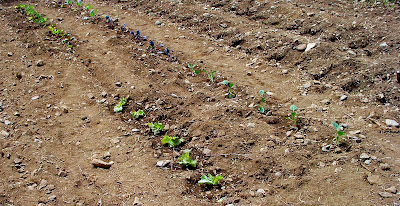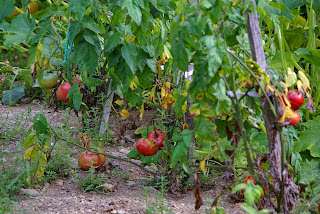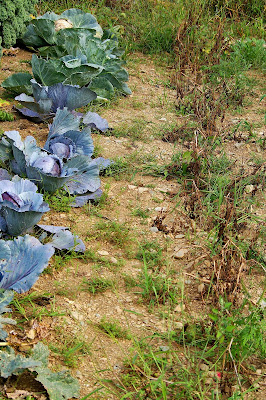 |
| First plantings, potatoes upper 2 rows, a row of brassica, some lettuce |
This was a year (2018) for only a little experimentation in the vegetable garden. About half of it was planted to beans, mostly dry beans, and by now I know the varieties I want to plant: Black Coco, Light Red Kidney, and Kenearly. The Earthway planter with the bean plate makes the planting go along easily and quickly after tilling over the soil. No-till wouldn't work; there are too many weed seeds still in the bed, perhaps a given with organic gardening and a reluctance to mulch heavily lest the slugs feast on the plants. Which means weekly cultivation next to the rows, using a wheel hoe and a long-handled hoe closest to the plants. After 90 days, they dry on the vine and on cords hung across the garden, then further in bunches of plants upside down in the barn.
 |
| Beans drying on a cord above and on the plants below, early September |
A few rows of each dry bean variety, and then a row and a half of Provider bush beans, whose combination of reliability, yield, and ability to hold their flavor after a few months in the freezer is unmatched. I did experiment with a new variety: half a row of Burpee Heavy Harvest bush beans, which was indeed as advertised, plentiful in its yield and tasty when eaten fresh; but it didn't freeze nearly as well as Provider. I planted out some Brandywine and Sungold tomatoes, not doing any paste tomatoes this year; as usual the Brandywine were delicious though not early nor plentiful, while the Sungold were delicious, early, and plentiful. Both varieties continued through till frost. In some years late blight gets the Brandywines but the Sungolds seem immune to it.
 |
| Brandywines are few and far between, late August |
I planted some Detroit Dark Red beets, and the usual red and green lettuces--no spinach this year--and a row of Red Gold potatoes (by far the tastiest variety, though it doesn't store long) and another row of Satina potatoes (exquisite for boiling and mashing). Normally Satinas store well, but not this year--I may have left them in the ground too long. General Lee cukes as usual were very tasty, as were Gentry summer squash--and very plentiful (the squash).
 |
| Cabbage at left, dying potato vines at right; August |
Broccoli and red and green cabbage as usual. The last experiment was dinosaur kale, which I transplanted out from plants bought at a nursery. In the past when planting kale from seed it hasn't done well here--it gets badly eaten by flea beetles, and it's not been worth the effort to put it under Reemay or some other covering. But the transplants did extremely well and I had kale to eat all summer, which I favor as a green over lettuce and most everything else. The kale held up right thru the fall frosts and into the winter freeze, also, but it lost its taste in the freeze. After harvesting all the beans I planted out oats mixed with red clover to hold the soil over the winter and by springtime this area of the garden will have had a bit of nitrogen from the cover crop and the beans that preceded it. Altogether this was an efficient garden, one that I didn't spend a lot of time working in, just enough, and although there was a period of about six weeks with almost no rain in the middle of summer, I was able to ration water from the rain barrels over the period into the garden to keep what needed water wet enough to keep going to a decent and in some cases good harvest.
I've read with pleasure the diaries of Newell Cotton, who lived in northern New Hampshire and grew a much larger garden than I do, some of which he took to market in nearby Lancaster. Much of the diary is taken up with entries from spring thru fall that have to do with planting, weeding, and harvesting. I'd guess he spent a couple of hours on average every day in his garden. I suppose I spent a few hours each week on average, in total. Of course, I could buy vegetables at the grocery store and spend a lot less time and labor in doing so, but I find so many benefits to growing much of my own vegetables that make it worth the expenditure of my effort. Knowing that the food is organic and more healthful makes me feel better (as does the food itself); I don't begrudge the labor for its repetition frees my mind to think, while at other times it is challenging and requires thought and decisions. There is, finally, satisfaction in being able to go out to the garden at any time to look at the way the vegetables are growing and progressing, to assess what else they may need (water? a side-dressing of compost? cultivation?), and to harvest snacks and meals throughout the summer and fall--a more direct connection between me and the food I eat than would obtain if I drove a truck or car to the grocery store to pick over vegetables that had been sprayed with pesticides and harvested before they were ripe, then doused with water or put on ice in shipment, to be freshened up at the grocery store so as to appear as if they were fresh-picked. How many more years I will be able to do this in retirement I don't know, but I do savor it all the more knowing that after nearly 40 years of growing vegetables in this garden I've gotten a lot more out of it than the vegetables themselves.















